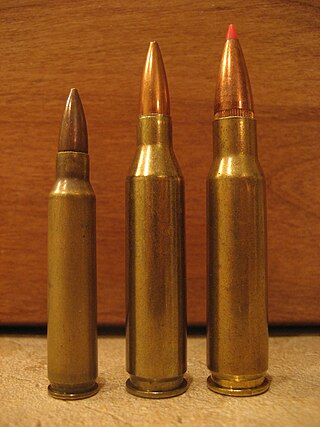
The .243 Winchester (6×52mm) is a popular sporting rifle cartridge. Developed as a versatile short action cartridge to hunt both medium game and small game alike, it "took whitetail hunting by storm" when introduced in 1955, and remains one of the most popular whitetail deer cartridges. It is also commonly used for harvesting blacktail deer, pronghorns and mule deer with heavier rounds, and is equally suited to varmint hunting with lighter rounds. The .243 is based on a necked down .308 Winchester, introduced only three years earlier. Expanding monolithic copper bullets of approximately 80 to 85 grains or traditional lead rounds of 90 to 105 grains with controlled expansion designs are best suited for hunting medium game, while lighter rounds are intended for varmints.
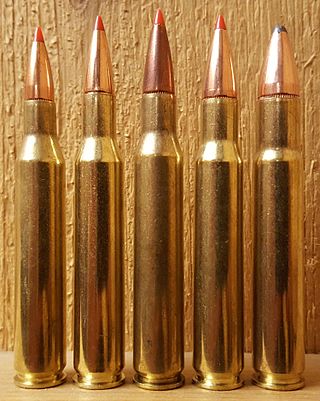
The .270 Winchester is a rifle cartridge developed by Winchester Repeating Arms Company in 1923, and it was unveiled in 1925 as a chambering for their bolt-action Model 54 to become arguably the flattest shooting cartridge of its day, only competing with the .300 Holland & Holland Magnum, also introduced in the same year.
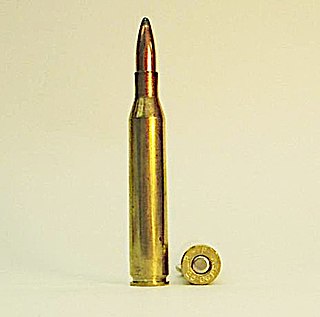
The .25-06 Remington was a wildcat cartridge for nearly half a century before being standardized by Remington in 1969.

The 7mm-08 Remington is a rifle cartridge that is almost a direct copy of a wildcat cartridge developed around 1958 known as the 7mm/308. As these names would suggest, it is the .308 Winchester case necked down to accept 7 mm (.284) bullets with a small increase in case length. Of cartridges based upon the .308, it is the second most popular behind only the .243 Winchester. However, the .308 is more popular than both. In 1980, the Remington Arms company popularized the cartridge by applying its own name and offering it as a chambering for their Model 788 and Model 700 rifles, along with a limited-run series within their Model 7600 pump-action rifles during the early 2000s.
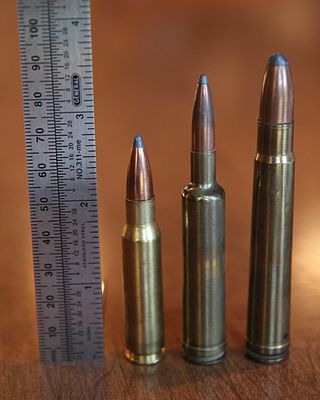
The .257 Weatherby Magnum is a .257 caliber (6.53 mm) belted bottlenecked cartridge. It is one of the original standard length magnums developed by shortening the .375 H&H Magnum case to approx. 2.5 in (64 mm). Of the cartridges developed by Roy Weatherby, the .257 Weatherby Magnum was known to have been his favorite, and the cartridge currently ranks third in Weatherby cartridge sales, after the .30-378 Weatherby Magnum and the .300 Weatherby Magnum.

The .375 H&H Magnum, also known as .375 Holland & Holland Magnum, is a medium-bore rifle cartridge introduced in 1912 by London based gunmaker Holland & Holland. The .375 H&H cartridge featured a belt to ensure the correct headspace, which otherwise might be unreliable, given the narrow shoulder of the cartridge case. The cartridge was designed to use cordite which was made in long strands – hence the tapered shape of the case, which, as a beneficial side effect also helped in smooth chambering and extraction from a rifle's breech.
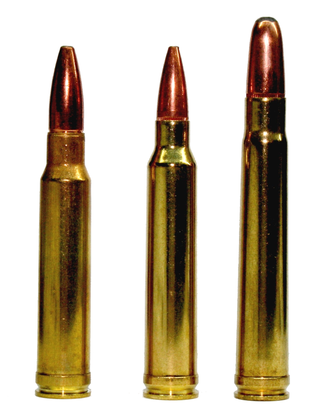
The .300 Winchester Magnum is a belted, bottlenecked magnum rifle cartridge that was introduced by the Winchester Repeating Arms Company in 1963. The .300 Winchester Magnum is a magnum cartridge designed to fit in a standard rifle action. It is based on the .375 H&H Magnum, which has been blown out, shortened, and necked down to accept a .30 caliber (7.62 mm) bullet.

The .338 Winchester Magnum is a .338 in (8.6 mm) caliber, belted, rimless, bottlenecked cartridge introduced in 1958 by Winchester Repeating Arms. It is based on the blown-out, shortened .375 H&H Magnum. The .338 in (8.6 mm) is the caliber at which medium-bore cartridges are considered to begin. The .338 Winchester Magnum is the first choice among professional brown bear guides in Alaska to back up clients where a powerful stopping caliber is required on charging bears. It is also the most popular medium-bore cartridge in North America and has the most widely available choice in rifles among medium bore rifles. The action length is the same as a .30-06, and most major rifle manufacturers in the United States chamber rifles for the cartridge including the semi-automatic Browning BAR Mk II Safari, making it a very powerful combination against charging dangerous game. The cartridge was intended for larger North American big-game species and has found use as for the hunting of thin-skinned African plains-game species.
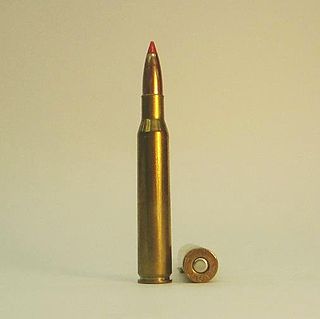
The .280 Remington, also known as the 7mm-06 Remington and 7mm Express Remington, was introduced in 1957 for the Remington model 740, 760, 721, and 725 rifles.

The 7mm Remington Magnum rifle cartridge was introduced as a commercially available round in 1962, along with the new Remington Model 700 bolt-action rifle. It is a member of the belted magnum family that is directly derived from the venerable .375 H&H Magnum. The original purpose of the belted magnum concept taken from the .300 H&H Magnum and .375 H&H Magnum, was to provide precise headspace control, since the sloping shoulders, while easing cartridge extraction, were unsuitable for this purpose. Improved cartridge extraction reliability is desirable while hunting dangerous game, in particular when a fast follow-up shot is required. The 7mm Remington Magnum is based on the commercial .264 Winchester Magnum, .338 Winchester Magnum, and .458 Winchester Magnum, which were based on the same belted .300 H&H Magnum and .375 H&H Magnum cases, trimmed to nearly the same length as the .270 Weatherby Magnum.

The 6mm Remington rifle cartridge, originally introduced in 1955 by Remington Arms Company as the .244 Remington, is based on a necked down .257 Roberts cartridge using a .24/6mm bullet. Known for a combination of high velocity, long range, flat trajectory, and accuracy, it is suitable as a dual use hunting cartridge for both medium-sized big game and varmints. When used in the less common earlier slow twist barrels, it offers exceptional range for varmint applications. While not as commercially popular today as the .243 Winchester, the 6mm Remington enjoys a slight ballistic advantage and continues to be popular with handloaders and custom rifle builders.

The 8mm Remington Magnum belted rifle cartridge was introduced by Remington Arms Company in 1978 as a new chambering for the model 700 BDL rifle. The 8mm Remington Magnum's parent case is the .375 H&H Magnum. It is a very long and powerful cartridge that cannot be used in standard length actions, such as those that accommodate the .30-06 Springfield.

The .35 Whelen is a powerful medium-bore rifle cartridge that does not require a magnum action or a magnum bolt-face. The parent of this cartridge is the .30-06 Springfield, which is necked-up to accept a bullet diameter of .358 in (9.1 mm). This cartridge is more powerful than its parent, especially in killing power on large game. However, with much wider availability, and the higher BC .30 caliber bullets of today, the power gap between the two cartridges has been decreased.
The .264 Winchester Magnum is a belted, bottlenecked rifle cartridge. Except for the .244 H&H Magnum and .257 Weatherby Magnum, it is the smallest caliber factory cartridge derived from the 2.85 in (72 mm) Holland & Holland belted magnum case. It was introduced in the late 1950s and early 1960s with the .338 Winchester Magnum and the .458 Winchester Magnum as one of a family of short-cased 2.5 in (64 mm) belted magnum cartridges developed by Winchester based on the .375 Holland & Holland parent case. It was officially introduced to the public by Winchester in 1959. After many years of dwindling use it began enjoying a mild resurgence in popularity in the mid-2000s among long range rifle enthusiasts and reloaders due to the high ballistic coefficient of the heavier 6.5mm bullets and increasing popularity of cartridges such as 6.5mm Creedmoor, .260 Remington, 6.5 Grendel, benchrest and wildcat cartridges in 6.5mm.

The .240 Weatherby Magnum was developed in 1968 by Roy Weatherby. In the development of his own .240in/6 mm cartridge, Weatherby was significantly influenced by both the success and the limitations of the .244 H&H Magnum cartridge devised in England by his friend and colleague David Lloyd. It was the last cartridge to be designed by Roy Weatherby.

The .270 Weatherby Magnum was the first belted magnum based on the .300 H&H Magnum to be developed by Roy Weatherby in 1943. The cartridge is short enough to function in standard-length long actions with a brass length of 2.549" or 64.74mm and an overall length of about 3.295".

.30-06 Springfield wildcat cartridges are cartridges developed from a 30-06 Springfield "parent cartridge" through narrowing or widening the cartridge neck to fit a smaller or larger bullet in an attempt to improve performance in specific areas. Such wildcat cartridges are not standardized with recognized small arms standardization bodies like the SAAMI and the CIP.

A varmint rifle or varminter is a type of small-caliber, precision-oriented long gun primarily used for varmint hunting and pest control. Such rifles are typically characterized by sniper rifle-like designs such as heavy free-floating barrel, enhanced bedding, ergonomic gunstock, the use of bipod/beanbag and high-power telescopic sight, and the choice of high-muzzle velocity, high-ballistic coefficient munitions, which are all accurizing features of needed for improving repeated shooting, often over long distances.
The .280 Ackley Improved was the result of the .280 Remington case modification by P.O Ackley, who pushed out the sidewalls at the shoulder to near parallel and steepened the shoulder angle to 40 degrees in order to increase powder capacity, thus along with increasing the allowable pressure, resulted in increasing the bullet initial velocity by approximately 100 fps.
The 6.8 Western is a centerfire rifle cartridge designed by Winchester Repeating Arms Company and Browning Arms Company. Introduced to the market in 2021 as a big game hunting cartridge that may be also used for long range target shooting.


















